 |
Rachel is undertaking the ambitious task of explaining the structure of a hologram, how it relates to data storage and then how it relates to models of the thinking process in the brain.
Eight in attendance. As always, Glenn's hospitality catalyzed the chemistry of concept exchange. Rachel was in excellent form.
There is an elemental finding on which holography is based. When a photographic plate is exposed to a pair of coherent light sources it captures all the essential information about the light waves hitting it.
 |
Of the pair, one of the original light sources - call it the object source - may be visually reconstructed. It is done by illuminating the developed photographic plate with the other source alone (now called the reference). The hologram is the developed photographic plate. It interferes with the reference beam so that only the difference beam emerges - the light that would have come from the object source.
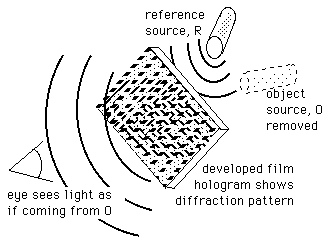 |
The reasons why this effect takes place, the physics behind it, the meaning and essential role of phase coherence in the process - these are fascinating topics but were not germane to Rachel's central theme: holography as explanation of how thought is processed in the brain.
The four important features of the holographic effect relative to how it may explain the mind's workings can be summarized as these:
1. Physical medium information storage. The pictorial information in a light beam can be stored in a physical medium. Pictorial information is the shape, form, and relative position of an object in real space. The physical medium is the hologram. It may be a photographic plate. There exist crystals in which distortions are imprinted by light. Such a crystal can act as a physical medium to store the information.
2. Complimentary space. The stored information is not a real space visual replica of the picture - as a simple photograph would be. Rather the information is stored in a complimentary space. The diffraction pattern is optically encoded information. It is the representation of the picture in wavelength space - albeit rendered into the real space of the storage medium.
3. Local-to-global mapping. An essential aspect of this encoding is that any one point of the real space picture is connected to all points of the diffraction representation. Conversely any one point in the diffraction pattern hologram concerns all points of the real space image.
This can be dramatically demonstrated.
Cut an ordinary photograph snipping a leg off the chair pictured. Then the chair leg is no longer visible. It is no longer part of the photographic image.
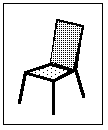 | 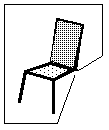 |
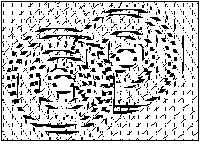 | 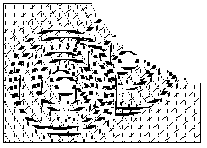 |
Two web references on holography are:
Now what has all this to do with thought, memory and the workings of the mind? Rachel explained it. She pointed us to the work of Karl H. Pribram of Radford University in Virginia, http://www.execpc.com/~ender13/brain/. His holographic theory of mind and its elaboration are presented in a series of essays gathered and edited by Ken Wilber in the book "The Holographic Paradigm", Shambala, London 1982.
The salient quote, according to Rachel, is: "...thought is a frequency effect. It transcends space and time."
The notion is based on the finding that memory seems to be distributed throughout the brain; that ideas are not accessed sequentially but rather all at once. This suggests that the brain is like a holographic medium. The information it receives comes from real space and time. But it is stored globally in a complimentary space provided by the brain.
Then, like the photograph-holograph analogue, if any local specific area of the brain is disabled no specific event is erased from memory. Rather all of memory fades or is distorted.
The analogy works with accessibility also. Information can be accessed beginning anywhere in the storage medium. And as the sweep of retrieval widens from that starting point more and more of the storage medium becomes involved so the information gets refined and sharpened. A small segment of a hologram contains the whole picture - albeit dimly. Illuminating a larger fraction of the hologram produces a clearer picture.
The effect is illustrated on the internet by the two kinds of gif pictures: normal and interlaced.
This picture loads sequentially - fully focussed - from top to bottom.
This version of the picture loads globally - from fuzzy to clear.
(Note of September 2005: In 1996 the internet was slow, downloading files at perhaps a few kilobits per second, so that it took a few seconds for the image to materialize. The viewer could visibly see it doing so. Now it is no longer possible except in the very slowest dial-up internet connections. The advances in internet information delivery speed made the effect disappear. Now the image is fully transferred in a time too small to visually see the transfer so both images seem fully present instantly.)
Jeff was sympathetic to the idea but felt that information storage is not restricted only to the brain. He feels data is stored in a 'field' pervading the whole body and its environs. Thinking does go on in the belly! The brain, says Jeff, is merely where the field is accessed.
Phil pointed out that people can lose short term memory and retain long term memory. There are at least two kinds of memory. How holographic brain theory accomodates this was not clarified. But reference beam misalignment was suggested(?).
Rachel said that the act of 'focussing attention' amounted to turning on a reference beam.
Glenn demonstrated the power of mnemonic devices for memory. When given the number at random - 7532 - he quickly translated it into LVMN and used the device 'leave men' to imprint it. Later when asked to reproduce the forgotten number he easily remembered 'leave men' and retraced the path through LVMN to 7532.
But is thought a coherent interference pattern of synapses? Said Don, "It would be very surprising if thought is coherent". To which Phil retorted, "Well, something has to be surprising!"
In what Rachel presented we see conjecture not a proven theory. A metaphore is not an explanation. The holographic theory of mind must stand or fall on testable hypotheses to establish its validity. What experiments have been done to test the theory?
Does thinking of a banana set up a reproducible diffraction pattern of activity in the brain? If so I would be very swayed by the theory. But I expect whatever pattern it does set up is not reproducible.
Of course no one expects the brain wave pattern to take the shape of a banana! So it is really the common expectation that thought takes place in some sort of complimentary space. The holography notion is merely an analogy to portray a popular idea. The hard work of establishing the notion does not seem to have been done. The trouble with metaphore is that is gives the illusion of understanding when, in fact, there is no understanding.
Roger pointed out that when telephones became popular so did the notion that the brain is like a telephone system. With the popularity of computers came the notion that the brain is a computer. The brain as hologram seems to fit this pattern.
Or does it?
October 1996
Marvin Chester
email
© m chester 1996 Occidental CA
Rachel's e-mail:
rachel@charmian.sonoma.edu